The City of Portland Bureau of Transportation (PBOT) has announced three open houses where you can learn more and offer input on their High Crash Corridor Safety program.
High Crash Corridors are roadways that, according to PBOT, “have exceptional concentrations of crash activity.” By identifying these corridors and putting them into a coordinated program, PBOT is able to target limited funding to make them safer. Current roads on the list include Portland’s most notorious arterials like SW Barbur, SE 122nd, SE Foster, SE 82nd, SE Powell, Marine Drive, SW Beaverton Hillsdale Hwy, SE Division and others.
We all know these roads kill and seriously injure Portlanders far too often. These open houses give you the chance to do something about them.
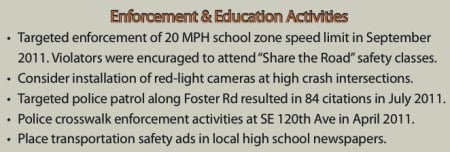
– Download the brochure here (PDF) –
PBOT spokesman Dan Anderson says the open houses, which start next Wednesday, will be a chance for people in the community to ask PBOT staff questions and review specific engineering, enforcement, and education options that the city uses to improve safety. PBOT will bring detailed crash maps to the open houses and attendees are encouraged to write their concerns and feedback on sticky notes for location-specific feedback.
PBOT will use feedback at the events to help shape the implementation strategies they choose for each corridor. By the end of this year, PBOT will develop a “Transportation Safety Report” for each corridor. Below are details on the open houses.
-
Marine Drive
Wednesday, February 15
6:30 – 8:30 PM, Columbia High School (small gym) (716 N Marine Drive)
SW Beaverton Hillsdale Highway
Wednesday, February 29
6:30 – 8:30 PM, Robert Gray Middle School cafeteria (5505 SW 23rd Ave)
SE Division Street
Wednesday, March 7
6:30 – 8:30 PM, Harrison Park K-8 School cafeteria (2225 SE 87th Ave)
If you live, work or ride near these streets, please consider attending and sharing what your experiences and feedback with PBOT staff.


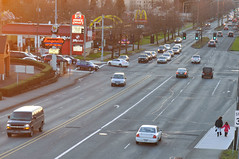
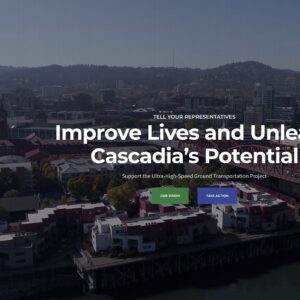
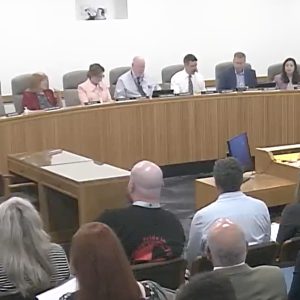

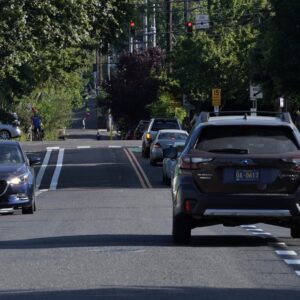
Thanks for reading.
BikePortland has served this community with independent community journalism since 2005. We rely on subscriptions from readers like you to survive. Your financial support is vital in keeping this valuable resource alive and well.
Please subscribe today to strengthen and expand our work.
Here’s a sad coincidence. I read this article about the PBOT open houses, and then went to the KATU site. Almost the first thing I saw was an article about a woman who was crossing Division in her wheelchair. She was struck by a car and died.
(a) “We all know these roads kill and seriously injure Portlanders far too often” & “PBOT will bring detailed crash maps”
(b)”PBOT will use feedback at the events to help shape the implementation strategies they choose for each corridor.”
I’m a big fan and proponent of public involvement, but given what I’ve learned here about PBOT follow through I’m less sanguine about the usefulness of this exercise, especially when PBOT already has all this detailed statistical information.
Or is Ted (recent comments on pedestrian crossing at E Burnside and 16th) correct that this is about finding the squeakiest wheels and generating a greasing schedule based on dB?
NO!! Roads are inanimate objects. They don’t kill people- people making bad choices, often while operating a motor vehicle, kill people.
Am I the only one that is starting to question if all these meetings about “unsafe streets” actually do any good?
Look, I drive quite a bit but don’t really like to. But I understand how destructive cars can be to the livable urban environment, and a reasonable solution to dangerous, fast corridors is a road diet to force people to slow down or use alternate routes.
It just seems to me like when these observations are made as a probable “best solution”, PBOT doesn’t posses the cojones to actually implement the changes. Look at Williams. The changes there to limit the road to one lane, slow traffic, and improve the environment for pedestrians and cyclists have been totally derailed. And with MORE development coming to that area, that will be even more important as more people live, work, and play on that corridor.
It’s easy to be a “model urban city” for visiting dignitaries and urban planners when you have a shiny urban university downtown, “sustainable LEED green buildings”, a tram system, and all of that fluff.
But when it comes to the nuts and bolts of truly making changes to be a different type of city than the status quo, I just don’t see Portland pushing back enough against entrenched interests.
Sorry, this rant is probably totally off-base, but I just want more out of my city planners that simple police enforcement.
I’m with you… I participated in the SE Foster Rd High Crash Corridor process, and the result was less than inspiring.
Yes, new median islands are good. More lighting is good. Curb Extensions are good.
On smaller, slower streets, these improvements might be all you need to improve safety. But on the big ones, the High Crash Corridors, they are not enough. The only real way to make a dramatic difference is to propose dramatic changes.
No, you’re on-base. You’re only off-base in apologizing for being off-base (which you’re not).
I wonder if the bikes vs streetcar rail crashes will be addressed. I’ve witnessed a few, and nearly went down myself.
Fixing these roads is crucial for the safety of not just pedstrians, but bicyclist too.
A case in point: last weekend, I like many cyclists, flocked to The Lumberyard on 82nd for the cyclocross event. It took my girlfriend and I about FIVE minutes to cross 82nd Avenue to get there, because of the high speed of the car traffic making it impossible to start making the four lane crossing on our bikes.
Coming out of the event, we decided to cross at a different location. Almost right outside the facility, about a block down in the other direction, there was a new crossing facility – a concrete island halfway across the road for peds. It took us 22 seconds to cross with this crosswalk there.
Safer crossing facilities save lives.
Crossing 82nd is super lame. I don’t know how ODOT can sleep at night.
Two Words: Access Management
Continuing my apparent theme this week of putting individual words under the microscope: ARTERIAL.
An artery is something that carries and supplies vital life blood that you literally cannot live without. If certain arteries are merely constricted (never mind severed) it will kill you. If someone even mentions doing anything or tampering with your arteries, you regognize it as a threat against your life and react accordingly. Is that an appropriate portrayal of SE Powell Blvd? Something to think about when talking about these streets. They’re just streets.
Submitted for consideration for the pantheon of lame transportation words, along with the “bicyclist/motorist/pedestrian” trio, and “fatality.”
ooh. I loove that Rol. Thanks for pointing that out. It’s tough because arterial is such a technical term that engineers and wonk types understand. But I definitely hear where you’re coming from and I’ll consider adding this to my growing style/word choice guide.
I have to disagree. If there is an objection to be made about using the term “arterial,” it’s that it’s not a term used by and comprehensible to the general public. But it is a correct word to describe a certain set of streets that, by policy, are designed to carry high vehicular volumes at relatively high vehicular speeds (and there are often “mobility guidelines” for arterial streets that hamper advocates’ efforts to tame them). Most cities have design guidelines that dictate what bicycle, pedestrian, and motor vehicle facilities should/must look like on arterials. In addition, arterials are often eligible for different funding pots of money and different priority status for capital investments.
By not using the correct and specific term “arterial” but rather talking around it (e.g. by calling every arterial a “major roadway with high vehicle volumes and speeds”), we lose the ability to convey these legal/policy limitations that affect streets that have been classified as arterials. As advocates, we should care about the systemic factors that are causing arterials to be toxic streets for humans and other living things. Using the same language of DOTs expresses our understanding of the system, and allows us to advocate for changes not just on individual arterial streets, but also in the policy framework as a whole.
I’m not saying we should always use the term arterial in every situation. Using compelling language is an essential part of advocacy. But it would be a mistake to allow our opinions about what the term “arterial” evokes to rob us of the ability to call a spade a spade (or an arterial an arterial).
Thanks Jessica. This language stuff is not always cut and dry so I appreciate having your professional input.
The Oxford English Dictionary says arterial is derived from arterial road. They pinpoint arterial road to an 1886 letter, while arterial by itself is noted as first used in a Wisconsin State Highway Commission Bulletin from 1920 (actually, they used arteries):
“The state highway commission may‥, by order, declare any state trunk highway or any city street‥to be arteries for through traffic.”
In that vein, it’s great to see people learning about the language, and the issues circulating around us.
I <3 PDX
In that “vein?” Har har!
So what you’re saying essentially in your first paragraph is:
1) Arterials exist.
2) They are designed according to the pertinent guidelines and policies.
3) They carry high traffic volumes at high speeds.
These, taken together, are in fact, THE PROBLEM. None of the above conditions are desirable. Policies to design arterials are not desirable, arterials to handle traffic are not desirable, traffic is not desirable, people driving cars is not desirable. Simple. I don’t want to remove the word arterial from the language; I want to remove arterials. And you thought I was crazy before! How dare I suggest something so flippant in a serious forum like the internet.
It will happen though. Probably the hard way (peak oil) and not through policy, because a sufficient majority of the populace is still in love with cars, and either scoffs or panics irrationally at the thought of making any REAL reduction to traffic volumes and speeds (i.e. NOT DRIVING). Sounds to me as though they think of such streets more like essential blood vessels and less like, I dunno, let’s say “baby-killers” or “cancer-alleys” or “frustration facilitators” or “money-sucking wealth-extraction facilities” or “runoff accelerators” or “dehumanizers” or any number of accurate, correct terms you could apply that aren’t DOT-endorsed. Go ahead and use “arterial” when you talk to the DOTs; they’re staunch car-supporting and car-enabling agencies, so they’ll understand that. But the general public needs its notions of reality re-framed and challenged, because they’re not hearing the message about the harm such a system does, and how easy it is to simply do something else. That’s the path to gathering a real majority (not just the small fringe special-interest group we are currently) and having real success in the political (policy) arena anyway. You can beg for table scraps or you can buy the table. You can appeal to the jury or you can stack it with your people. “I have a dream…”
I also disagree with the parent; simply because SE Powell and SE Foster *are* arterials. If you’re in outer SE, there is simply no other reasonable option to get to inner SE in a vehicle without clogging smaller roads such as SE Holgate or SE Division, or driving extra miles by jogging to I-84 and clogging 39th or 11th.
Were we to shut down those roads entirely, the traffic system in East Portland would be paralyzed and thousands of Portlanders would be in their cars for much longer than they already are, which does bicyclists and pedestrians no favors. This, to me, fulfills the definition of ‘arterial’.
We need to step up traffic enforcement on these roads. We need to improve bicyclist and pedestrian access to these roads. We don’t need to be mealy-mouthed and avoid offending someone’s sensibility by inventing new terms for these roads.
The definition fails because humans, unlike blood cells, will notice the inconvenience and decide to ride a bike, take public transit, or move to a sensible non-stupid location close to their frequent destinations. I am walking all this talk so I know it can be done.
Do onto 122nd and 82nd what you have done to Interstate.
One thing that has me confuzzled is they know where the wrecks are, they know what needs to be done to reduce wrecks in the future, why are they having public meetings and requesting “input”? Are they going to crowdsourced engineering now? Or are they (as I suspect) just going to make things either 1) worse or 2) no better just different by throwing token amounts of money at the situation and claiming “It’s what ‘the People’ want”?
Sorry, too much time dealing with people that make huge plans and when the money hits the road we get more of the same except bigger.
How can PBOT best target safety resources to streets like these? Seems like the easiest and cheapest thing they could do is lower the speed limit. I believe you have covered a lot of studies on Bikeportland.org that suggest lower speeds save lives. It is a no brainer…if we were serious about this it would be the first step.
Lower speeds save lives, no doubt. Problem is that lower speed limits don’t always mean lower speeds unless you back them up with enforcement.